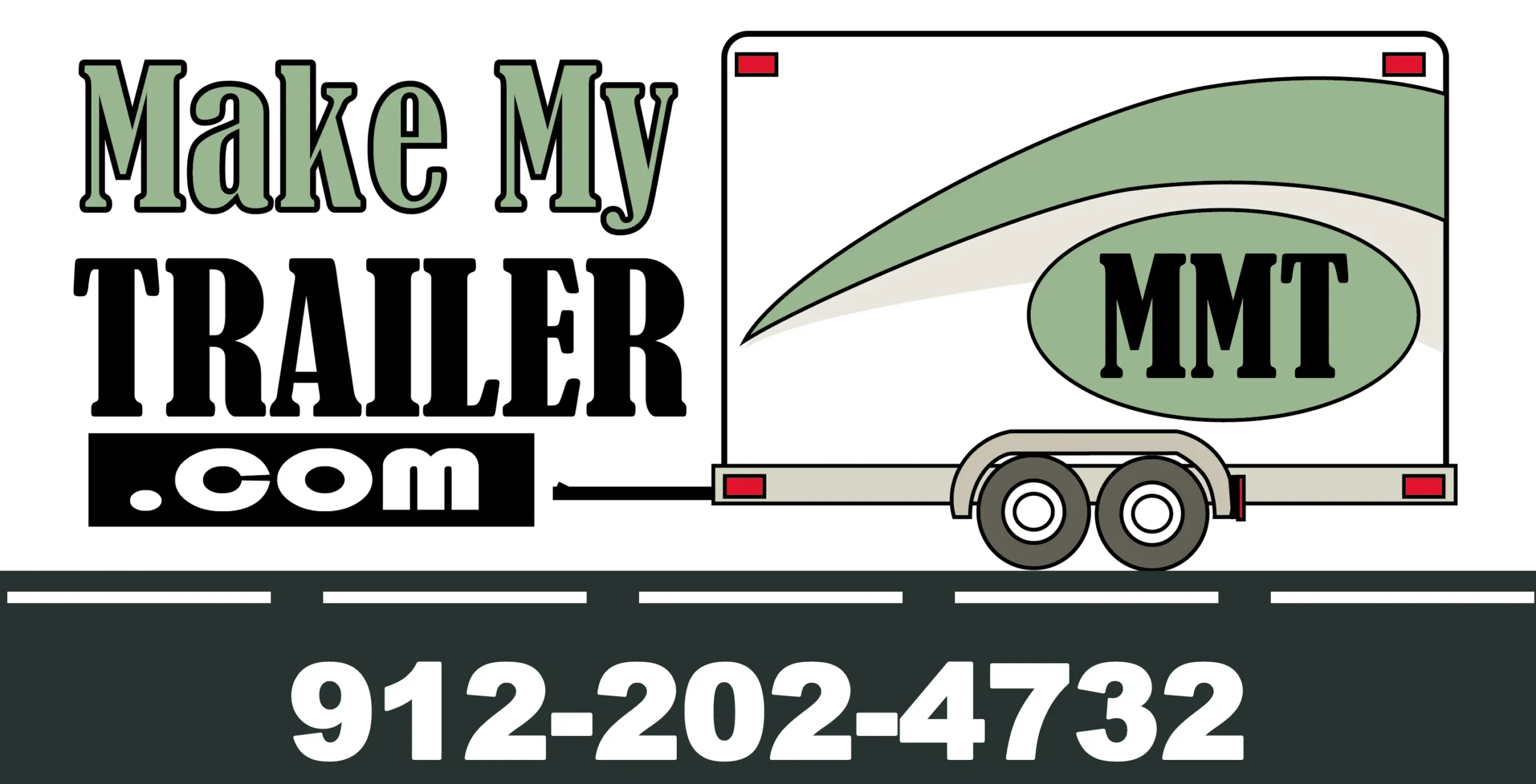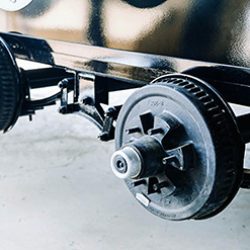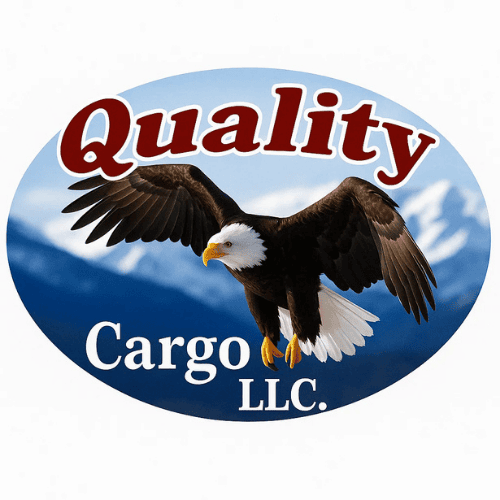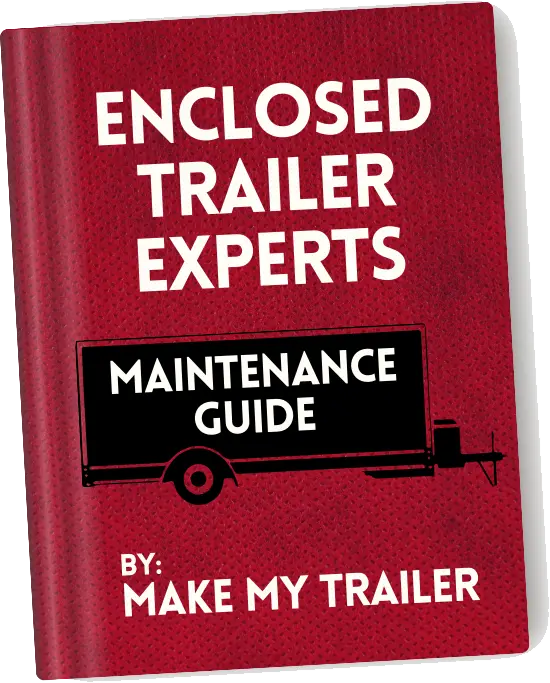Everything you need to know about the
7x20 Double Axle - Quality Cargo
- 7×20 Double
- Maintenance & More
7x20 Double Axle - Quality Cargo
1. Technical Features Table
→ → →
| Standard Features | Quality Cargo |
| PRICE | $6,425.00 |
| EXTERIOR METAL | .024 metal exterior Semi-Screwless exterior |
| AXLES | Tandem 3500 lb Spring axles with 4" drop |
| ELECTRIC BRAKES | Electric brakes |
| V-NOSE | V-Nose with vertical ATP trim |
| DOME LIGHT | 12V Dome light with switch |
| WALLS/CEILING TUBING | 1"x1 " steel tube in walls and ceiling |
| FLOOR TUBING | 6" Steel Tube Main Frame |
| FLOOR CROSS-MEMBERS | Floor crossmembers 16" O.C. |
| ROOF CROSS-MEMBERS | Roof members 24" O.C. |
| WALL CROSS-MEMBERS | Wall members 16" O.C. |
| LIGHTS | LED Strip tail lights |
| INTERIOR HEGHT | 75" (6'3") Interior height |
| REAR DOOR | Double rear door w/bar lock or ramp |
| PLUG / COUPLER (BALL) | 7-way Bargman plug 2-5/16" coupler |
| FENDERS | Aluminum Fender w/Lights |
| SIDE DOOR | 32" RV style side door with flush lock |
| TIRES | 15" Tires |
| RIMS/WHEELS | Silver Mod Wheels |
| ROOF MATERIAL | Galvalume roof |
| TONGUE JACK | 2000 lb tongue jack |
| HUBS | EZ Lube Hubs |
| WALL MATERIAL | Premium 3/8" plywood sidewalls |
| FLOOR MATERIAL | 3/4" plywood floor/painted underneath |
| VENTS | Non-powered roof vent or sidewall |
| EMPTY WEIGHT | 3000 lbs |
| LOAD CAPACITY | 4000 lbs |
| GVWR | 7000 lbs |
| TONGUE WEIGHT | 396 lbs |
2. Technical FAQ

Overall Length: 23’6″ / 282 in (Breakdown: 20′ on the Box + 3’6″ on the Tongue) 20″ on the Vnose
Overall Width: 8’6″ / 102 in (Breakdown: 7′ on the Box + 9″ on each Fender)
Overall Height ( Diamond ): 8’4″ / 100 in (Breakdown: 7′ on the Box + 16″ from the ground to the box)
Overall Height (Anvil): 7’7″ / 91 in (Breakdown: 6’3″ on the Box + 16″ from the ground to the box)
Overall Length: 19’9″ Box (Breakdown: Subtract 3″ which counts for rear door & framing) plus 20″ on the Vnose
Overall Width: 6’8″ (Breakdown: Subtract 4″ (2″ on each side) which counts for plywood & framing)
Overall Height ( Diamond ): 7′
Overall Height (Anvil): 6’3″
Width: 74″ (Breakdown: Subtract 10″ (5 on each side) which counts for plywood & framing)
Height ( Diamond ): 78″ (Breakdown: Subtract 6″ which counts for plywood & framing)
Height (Anvil): 69″ (Breakdown: Subtract 6″ which counts for plywood & framing)
7-way Round plug
5×4.5 (5 Lug)
6 Ply
Screws are 4′ apart instead of being every 2′
It’s an asphalt undercoating paint
We developed a section exclusively for Custom Options where we show sample photos and explain most popular options:
Click Here for More Information.
Here are examples of some of the most popular Custom Options:
– Blackout Package
– Electrical Package
– Insulation Package
– Rubber Flooring
– Etracks
– D-rings
– Windows
– Extended Tongue
– Extra Height
– Ladder Racks
– Finished Interior (Metal/Vinyl)
– Air Conditioner
– Lighting Options
– Axle Upgrades
– Concession Window
– Special Door Options
– Cabinets
– Barn Doors
3. Sample Photos
4. Sample Video

5. Sample Colors (Click to enlarge)
6. Purchase FAQ
Click the link below for Financing Options:
https://makemytrailer.com/enclosed-trailer-financing-services/
Click the link below for Delivery Options:
https://makemytrailer.com/delivery/
30 Day Temporary Tag, Certificate of Origin and obviously your Title so you can register your brand new trailer
Yes they are and also the reason why your trailer pick up is directly at the Factory.
We do not charge any taxes, that’s something that you pay when you register the trailer
Yes, as soon as your trailer is ready we can provide your with your VIN number.
1) Credit or Debit Card (over the phone or invoice sent to your email)
2) Mail a Cashier’s Check
3) Wire Transfer
Once your deposit is confirmed we’ll send you an email just make everything official and after 24 hours (timeframe we provide in case of any changes) we will send your order to our production team so they can start working on your future top notch trailer
It depends on 2 factors: The season and your Order so make sure to ask our awesome sales team for a more accurate completion timeframe but on average you might be looking between 2 to 4 weeks on standard order and about 3 to 5 weeks for orders with custom options.
Note: We do make exceptions so make sure to ask our sales team
We don’t usually provide any updates during the building process but we can definitely ask our production team how things are going but as soon as your trailer is ready, we will send you the completion email along with the instructions so you can start your pick up arrangements
By clicking Buy Now, you will be redirected to our secure PayPal checkout page. A deposit is required to reserve the standard version of this trailer size. The remaining balance, including any selected options or upgrades (such as A/C or insulation), will be due at pickup or delivery. Final price may vary depending on manufacturer and features. Please contact us to confirm details before completing your order.
7. Get a Quote
Have you recently invested in an enclosed cargo trailer, or are you looking to maximize the lifespan and efficiency of your current one? Our comprehensive PDF guide is your ultimate companion to mastering the art of trailer maintenance!
- Step-by-step instructions on pre-use checks to ensure safety and readiness for the road.
- Expert advice on periodic maintenance routines to keep your trailer in peak condition.
- DIY tips for interior and exterior care, from flooring maintenance to rust prevention.
- Winterizing strategies that protect your investment through the coldest months.
- Essential insights into tire care, brake maintenance, and the importance of proper ventilation.
- Bonus content: Safety equipment checklist, emergency preparedness, and much more!
Safeguard Your Investment:
10 Smart Ways to Prevent Trailer Theft!

The Ultimate Guide to Choosing Your Quality 7x20 Double Axle Cargo Trailer
Introduction: Why the 7×20 Double Axle Cargo Trailer is Your Smart Choice
When it comes to hauling substantial loads, whether for business or personal projects, choosing the right tool is paramount. A 7×20 double axle cargo trailer strikes an exceptional balance between size, capacity, and maneuverability, making it a popular choice for contractors, landscapers, motorsports enthusiasts, and small business owners. This enclosed cargo trailer offers ample space while its tandem axle design provides the stability and payload capacity needed for serious work.

The Allure of the 7×20: Versatility, Space, and Stability
The 7-foot width provides generous interior room without being overly cumbersome on the road, while the 20-foot length can accommodate everything from construction materials and landscaping equipment to multiple ATVs or a classic car. The key to its capability, however, is the double axle configuration. This design distributes weight more evenly, enhances stability at highway speeds, improves braking performance, and offers a crucial safety redundancy in case of a tire blowout. These trailers are built to handle consistent, heavy use.
What This Guide Will Cover: Your Roadmap to a Quality Purchase
Purchasing a trailer is a significant investment. This comprehensive guide will walk you through every critical detail to consider. We will cover how to assess your specific needs, decode technical specifications like axle ratings and GVWR, evaluate construction quality, and understand essential safety features. By the end, you will have the knowledge to select a high-quality 7×20 tandem axle trailer that perfectly suits your requirements and delivers lasting value.
Understanding Your Needs: Is a 7×20 Double Axle Right For You?
Before diving into specifications, the first step is a clear assessment of your own needs. A trailer that is too small will be limiting, while one that is too large can be inefficient and difficult to manage. The 7×20 size hits a sweet spot, but confirming it’s the right fit is crucial for a smart purchase.
Defining Your Primary Use Case (Who Needs a 7×20 TA Trailer?)
This size and configuration are ideal for a range of users. Contractors often choose them to create mobile workshops or securely transport valuable tools and materials to job sites. Landscaping companies can easily haul multiple zero-turn mowers and equipment. Powersports enthusiasts can fit several dirt bikes or a UTV inside, protected from the elements. Small businesses, from mobile pet groomers to delivery services, find the enclosed space perfect for their operations. If your cargo is bulky, heavy, or requires protection, this trailer is a strong contender.
Estimating Your Cargo: Weight, Dimensions, and Payload Needs
The most critical calculation is your required payload capacity. Start by listing everything you plan to haul and find their total weight. Don’t forget to account for miscellaneous items like fuel cans, tools, and securing equipment. Next, consider dimensions. Measure your largest pieces of equipment to ensure they will fit, paying close attention to the necessary interior height. A trailer with a standard 6’3″ interior might not be sufficient for a taller UTV, necessitating an upgrade. Accurately estimating your cargo ensures you don’t overload your trailer, a key factor for safety and longevity.
The Backbone of Your Trailer: Axles, Tires, and Gross Vehicle Weight Rating (GVWR)
The undercarriage of a trailer is its foundation. The quality of the axles, tires, and overall weight rating dictates its performance, safety, and durability. For a 7×20 trailer, these components are not just features; they are the core of its capability.
Why a Double Axle (Tandem Axle) is Crucial for a 7×20 Trailer
A single axle simply cannot safely manage the potential weight and length of a 7×20 trailer. A tandem axle configuration offers indispensable benefits:
- Increased Payload Capacity: Two axles can support significantly more weight than one.
- Enhanced Stability: The four-tire footprint minimizes sway from crosswinds and passing vehicles, providing a more controlled towing experience.
- Improved Braking: With brakes on all four wheels (a standard feature on quality tandem axle trailers), stopping power is dramatically increased.
- Redundancy: If one tire fails, the other three can support the load temporarily, allowing you to pull over safely.
Understanding Axle Ratings and GVWR
Each axle has a weight rating, typically 3,500 lbs or 5,200 lbs for this size of trailer. Two 3,500 lb axles create a trailer with a Gross Vehicle Weight Rating (GVWR) of 7,000 lbs. The GVWR is the maximum total weight of the trailer and its cargo combined. It’s a critical safety limit set by the manufacturer. Subtracting the trailer’s empty weight from the GVWR gives you the maximum payload capacity—the true amount of cargo you can safely haul. Always choose a trailer with a GVWR that comfortably exceeds your heaviest anticipated load.
Tire Selection: Radial, Ply Rating, and Wheels for Performance
Tires are your trailer’s only connection to the road. Opting for Radial Tires is a non-negotiable for quality. Compared to older bias-ply tires, radials run cooler, have a longer tread life, and provide a smoother, more stable ride. Check the tire’s load range (e.g., Load Range C or D), which indicates its strength and inflation pressure limits. These tires are mounted on wheels, which are typically steel for durability, though aluminum options are available for reduced weight and improved aesthetics.
Hitching Up: Coupler, Safety Chains, and Hitch Weight
Connecting the trailer to your vehicle securely is vital for safety. A 7×20 tandem axle trailer will almost always use a 2-5/16 inch coupler to attach to the tow vehicle’s hitch ball. Ensure your vehicle’s hitch is rated for this size. Safety chains are a required backup connection, and a breakaway kit (which activates the trailer brakes if it detaches) is another essential safety device. Finally, be mindful of hitch weight—the downward force on the hitch—which should be 10-15% of the total trailer weight for stable towing.
Superior Construction and Materials: Building a Quality 7×20 Trailer
The long-term durability of a cargo trailer is determined by the quality of its construction, from the unseen frame to the exterior skin. A well-built trailer will withstand years of use and exposure to the elements, while a poorly constructed one will quickly show signs of wear and failure.
Frame Integrity: The Unseen Foundation of Durability
The main frame is the trailer’s skeleton. Look for frames made from rectangular steel tubing, which offers superior strength and resistance to twisting compared to C-channel or angle iron. Pay close attention to the spacing of the crossmembers (the beams supporting the floor). A spacing of 16 inches on-center (O.C.) is significantly stronger and more durable than a 24-inch spacing, especially when carrying heavy, concentrated loads. The same principle applies to wall studs and roof bows.
Exterior Shell: Protection from the Elements and Aesthetics
The exterior skin protects your cargo. Aluminum is a common material, but look for thickness details (e.g., .024″ or .030″). Many modern trailers offer .080 Polycore siding, which consists of a polyethylene core bonded between two sheets of aluminum, providing a thicker, more durable, and smoother finish. Also, consider the fastening method. While some trailers use visible screws to attach the panels, a “screwless” or “semi-screwed” exterior, which uses high-strength adhesive, offers a cleaner look and fewer potential points for water intrusion.
Interior Flooring and Walls: Ready for Your Cargo
The interior must be robust enough to handle your specific cargo. The industry standard for quality flooring is 3/4-inch plywood, which provides excellent strength and impact resistance. For walls, 3/8-inch plywood is common and offers a solid surface for mounting shelves or tie-down systems. Ensure the underside of the flooring has a protective undercoating to guard against moisture and road debris, preventing rot and extending the trailer’s life.
Aerodynamics and Design: The V-Nose Advantage
Many enclosed cargo trailers feature a V-nose design instead of a flat front. This angled front provides an aerodynamic advantage, reducing wind resistance during towing. This can lead to improved fuel economy for the tow vehicle and better handling, especially in windy conditions. The V-nose also adds a small amount of extra interior storage space at the front of the trailer, perfect for shelves or cabinets.
Essential Features for Access, Security, and Lighting
Functionality is defined by features that make a trailer easy and safe to use. Door configurations, lighting systems, and security measures are practical details that have a significant impact on your day-to-day experience.
Door Configurations: Tailoring Access to Your Cargo
The most common rear door option is a spring-assisted ramp door, which is essential for loading wheeled equipment like mowers, ATVs, or dollies. Look for ramps with a transition flap to ease the angle. For users who primarily load with a forklift or don’t need to roll cargo in, double barn doors may be a better choice. A side door is a standard feature that provides convenient walk-in access without having to lower the rear ramp. A quality side door will feature a secure RV-style latch and a secondary bar lock for added security.
Lighting and Electrical Systems: Visibility and Safety
Proper lighting is a matter of legal compliance and safety. Modern trailers should exclusively use LED lights. They are brighter, last significantly longer, and draw less power than traditional incandescent bulbs. The trailer connects to the tow vehicle via an electrical plug, typically a 7-way round connector. This plug powers the running lights, brake lights, turn signals, and, most importantly, the electric brakes.
Security and Convenience Features
Security starts with robust door locks. The side door’s RV-style latch can be locked, and the rear ramp or barn doors should have hasps designed for heavy-duty padlocks. Inside, features like D-rings bolted to the frame and E-track systems mounted on the walls or floor provide versatile and secure tie-down points for your cargo. Other convenience features to look for include a non-powered roof vent for air circulation and interior dome lights for visibility.
Safety First: Braking Systems and Regulatory Compliance
When hauling thousands of pounds, safety cannot be an afterthought. Braking systems and adherence to transportation regulations are non-negotiable aspects of responsible trailer ownership.
The Non-Negotiable: Electric Brakes for Tandem Axles
Due to their weight capacity, all tandem axle trailers must have their own braking system. Electric brakes are the industry standard. They are synchronized with the tow vehicle’s brakes via a brake controller installed in the cab. When you press the brake pedal, the controller sends an electrical signal to the trailer’s brakes, providing smooth, proportional stopping power. Brakes on both axles are essential for maximum safety and control.
Understanding DOT Regulations and the VIN Number
Trailers intended for use on public roads must comply with Department of Transportation (DOT) regulations. This includes requirements for lighting, reflectors, safety chains, and tires. A compliant trailer will have a Vehicle Identification Number (VIN) plate or sticker, usually located on the A-frame of the tongue. This plate lists the VIN, GVWR, and manufacturer details, serving as the trailer’s official identity for registration and insurance.
Customization and Options: Making Your 7×20 Uniquely Yours
While standard models are highly capable, one of the benefits of buying a new trailer is the ability to customize it with options that enhance its functionality for your specific needs.
Popular Upgrades for Functionality
Common functional upgrades focus on capacity and convenience. Upgrading from 3,500 lb to 5,200 lb axles increases your payload capacity significantly. Taller interior height is a popular option for hauling UTVs or for users who need to stand upright inside. Adding extra D-rings, E-track, or a spare tire and mount are practical additions. You can also upgrade to aluminum wheels or add stabilizer jacks for when the trailer is unhitched.
Aesthetic and Branding Options
For businesses, a trailer is a mobile billboard. Many manufacturers offer a wide array of exterior color options beyond standard white or black. You can also opt for a screwless exterior for a clean, smooth surface that is perfect for applying vinyl graphics and company branding. Upgraded wheels and chrome trim can further enhance the professional appearance of your trailer.
Specialized Builds: Adapting for Specific Uses (Custom Options)
Beyond simple upgrades, manufacturers can often build a trailer for a specific purpose. This can include adding concession windows and plumbing prep for a food trailer, installing insulation and power packages for a mobile office, or reinforcing the frame and ramp for hauling exceptionally heavy equipment. Discussing your unique needs with a dealer can open up a world of custom possibilities.
Choosing a Quality Manufacturer and Dealer
The final step is selecting where to buy your trailer. The reputation of the manufacturer and the service provided by the dealer are just as important as the trailer’s specifications.
What Truly Defines “Quality Cargo” in a Trailer
A quality cargo trailer is more than just a list of features. It’s defined by the integrity of its build. Look for a manufacturer with a strong reputation for consistent quality, positive customer reviews, and a solid warranty. Quality is evident in the details: clean welds, properly routed and protected wiring, precise fits on doors and seams, and the use of reputable components like Dexter or Lippert axles. A quality trailer is an investment that provides reliability and peace of mind. Consider all these details before looking into Financing.

Conclusion
Choosing the right 7×20 double axle cargo trailer is a process of matching your specific hauling needs with a well-constructed, safe, and reliable product. By focusing on the fundamentals—a strong tandem axle foundation, robust frame construction, and critical safety systems like radial tires and electric brakes—you can confidently navigate the market. Define your payload requirements, inspect the construction quality beyond the surface, and select options that add real functionality for your use case. Armed with this knowledge, you are now prepared to make an informed decision and invest in a quality trailer that will serve as a dependable asset for years to come.
Next Up>>> 8.5×12 double axle quality cargo






